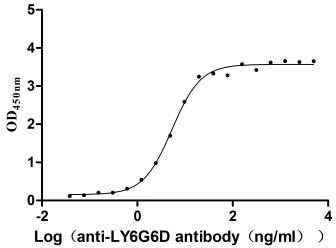This recombinant Macaca fascicularis lymphocyte antigen 6 family member G6D (LY6G6D) protein, spanning residues 20-104, is expressed in yeast with an N-terminal 6×His tag. The protein exhibits high purity (>95% by SDS-PAGE) and low endotoxin content (<1.0 EU/μg, LAL method), ensuring suitability for immunological studies. Functional validation via ELISA demonstrates specific binding to anti-LY6G6D antibody (CSB-RA013246MA1HU) with an EC50 of 3.963–7.154 ng/mL when immobilized at 2 μg/mL, confirming proper folding and antigenicity. The yeast expression system provides cost-effective production while maintaining structural integrity, though post-translational modifications may differ from mammalian systems. Presented as lyophilized powder, this recombinant LY6G6D protein ensures stability and ease of reconstitution. The N-terminal 6xHis tag facilitates purification without interfering with functional epitopes. This recombinant LY6G6D serves as a critical tool for investigating immune regulation, lymphocyte signaling pathways, and potential therapeutic targeting in oncology or infectious disease models, particularly in non-human primate research frameworks.
The LY6G6D protein in Macaca fascicularis (cynomolgus macaque) is part of the LY6 superfamily, characterized by a conserved LY6 domain that plays significant roles in immune system function. While specific studies on LY6G6D in Macaca fascicularis are limited, parallels can be drawn from research on other members of the LY6 superfamily, which suggest essential functions within the immune response.
Studies indicate that proteins of the LY6 family can act as co-stimulatory molecules on lymphocytes, influencing their activation and proliferation [1][2]. In the context of cynomolgus macaques, understanding such proteins is crucial for leveraging them as models in biomedical research [3][4].
The versatility of the LY6 protein family is evident from various studies demonstrating their participation in biological processes, including immune regulation and host defense [5]. Proteins from the LY6 family contribute to the innate and adaptive immune responses, suggesting that LY6G6D may likewise influence these responses in Macaca fascicularis. Furthermore, evolutionary studies have indicated that Macaca species, including Macaca fascicularis, exhibit significant genetic similarities and diversities with humans, underscoring their relevance in translational research contexts focused on immune responses [6][7].
Thus, LY6G6D's role can be inferred from its structural characteristics and its membership in the LY6 protein family. Given the evolutionary conservation among these proteins, it is likely that LY6G6D in Macaca fascicularis fulfills critical functions related to immune cell signaling and differentiation, essential for adaptive immune capabilities.
References:
[1] L. Ylinen, A. Price, et al. Conformational adaptation of asian macaque trimcyp directs lineage specific antiviral activity. Plos Pathogens, vol. 6, no. 8, p. e1001062, 2010. https://doi.org/10.1371/journal.ppat.1001062
[2] F. Liu, Y. Kuang, D. Mu, H. Zheng, J. Zhu, & Y. Zheng. The effect of exon 7 deletion during the evolution of trimcyp fusion proteins on viral restriction. cytoplasmic body formation and multimerization, Plos One, vol. 10, no. 3, p. e0121666, 2015. https://doi.org/10.1371/journal.pone.0121666
[3] S. Kanthaswamy, J. Ng, et al. The genetic composition of populations of cynomolgus macaques (macaca fascicularis) used in biomedical research. Journal of Medical Primatology, vol. 42, no. 3, p. 120-131, 2013. https://doi.org/10.1111/jmp.12043
[4] S. Laila, D. Astuti, I. Suparto, E. Handharyani, T. Register, & D. Sajuthi. Atherosclerotic lesion of the carotid artery in indonesian cynomolgus monkeys receiving a locally sourced atherogenic diet. Veterinary Sciences, vol. 9, no. 3, p. 105, 2022. https://doi.org/10.3390/vetsci9030105
[5] L. Ramsay, M. Quillé, et al. Blood transcriptomic biomarker as a surrogate of ischemic brain gene expression. Annals of Clinical and Translational Neurology, vol. 6, no. 9, p. 1681-1695, 2019. https://doi.org/10.1002/acn3.50861
[6] M. Abdul‐Latiff, F. Ruslin, et al. Continental monophyly and molecular divergence of peninsular malaysia’smacaca fascicularis fascicularis. Biomed Research International, vol. 2014, p. 1-18, 2014. https://doi.org/10.1155/2014/897682
[7] B. Koo, D. Lee, et al. Reference values of hematological and biochemical parameters in young-adult cynomolgus monkey (macaca fascicularis) and rhesus monkey (macaca mulatta) anesthetized with ketamine hydrochloride. Laboratory Animal Research, vol. 35, no. 1, 2019. https://doi.org/10.1186/s42826-019-0006-0








